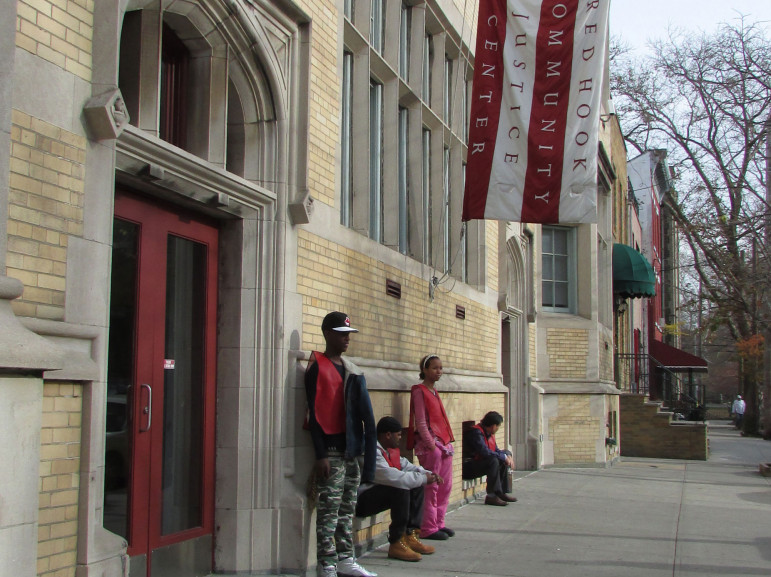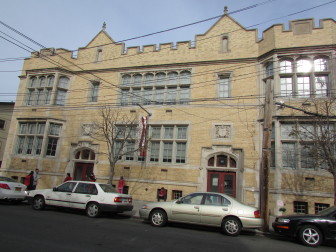
Roxanna Asgarian / JJIE
Red Hook Justice Center, Brooklyn, N.Y
BROOKLYN, N.Y. -- On a recent afternoon in a Red Hook courtroom, a disheveled young woman in a baggy blue sweatshirt was being sentenced for a drug-related offense. The judge had seen her in court before, always for arrests related to her heroin addiction.
Judge Alex Calabrese, a paternal-looking middle-aged man, asked her to approach the bench.
“Are you ready?” he asked her, looking into her eyes. “Yes,” she responded.
He reached out and took her hand.
“Are you gonna get on the bus? Are you gonna stay on the bus?” he asked, and she nodded. “Yes.”
 Calabrese signed the paperwork for her to enter a mandatory detox and rehabilitation center, and she was to leave on a bus from the courtroom to the rehab facility in ten minutes.
Calabrese signed the paperwork for her to enter a mandatory detox and rehabilitation center, and she was to leave on a bus from the courtroom to the rehab facility in ten minutes.
“She got picked up last night at 6:30 p.m., and she’ll be on a bus to rehab at 3:30 today,” Calabrese said. “That’s good work.”
The Red Hook Justice Center’s hands-on approach isn’t limited to the courtroom. The building was specifically designed to “humanize” the courthouse experience. Rooms are filled with natural light from big windows, and shatterproof glass replaces bars on the cells where offenders are detained until their trials.
The grounded judge’s bench allows the defendant to be at eye-level with the judge during the trial, and you are more likely to hear Judge Calabrese give out orders for mandated mental health services or anger-management classes than you are to hear a jail sentence.
Where in traditional courts, the defendant may meet with their public attorney just minutes before their trial, at the Justice Center, onsite social workers can meet with the defendant and come up with alternatives to incarceration, like mandated community service or treatment, before the offender meets with a judge.
For young residents of Red Hook, where 70 percent of the neighborhood lives in public housing, the chance to keep their record clean, or clear it, can make a world of difference in the opportunities they’ll have for their future.
“It's not that complicated an idea,” said Julian Adler, the Justice Center’s director. “It's just something that you don't typically see in the criminal justice system.”
And according to a report released Tuesday by the National Center for State Courts, their nontraditional approach is working. The report found that juvenile defendants were 20 percent less likely to re-offend when their cases had been heard at the Justice Center instead of at the Kings County Family Court.

Roxanna Asgarian / JJIE
Red Hook Justice Center, Brooklyn, N.Y.
The report, funded by the National Institute of Justice, was commissioned in 2009, nine years after the center opened, to gauge the impact of the Justice Center on crime, costs, and incarceration rates. It found that incarceration rates overall were much lower than those downtown (only one percent of sentences involve jail time compared to 15 percent in Kings County court), but the rate of defendants who walk away with just a fine or time served is much lower at the Justice Center.
And if the defendant fails to complete the mandated service or treatment sentence, the average jail sentence can be much longer. Their priority, though, is to avoid incarceration whenever possible.
“With young people, we have a core commitment to resolve things without convictions,” Adler said. “We recognize that an arrest is a moment of crisis and opportunity, and certainly with a young person who doesn't have a record, we try to get them out of the system without the taint of a criminal conviction.”
The court, which hears family, housing, and low-level criminal cases, is focused on finding mostly service-based alternatives to jail time — nearly 80 percent of sentences handed down involve community or social service sentences, compared to 20 percent downtown, the report found.
The center has partnered with community groups like Groundswell, a Red Hook–based mural project, and Red Hook Initiative, which provides neighborhood youth programs, to make sure the required service hours are filled within the community, so the neighborhood can feel the positive impact.
The center also houses a GED program, arts programs, and Youth Court, where low-level juvenile offenders are brought in front of a court of their peers -- including a teen judge, jury, and community and youth advocates that fill the roles of prosecutor and defender. Teen offenders have a chance to tell their story and are asked questions by the jury before being given a sanction, such as a letter of apology or an act of service.
Aaliyah Rogers had just turned 17 when she got arrested for petty larceny and was sent to Youth Court. She had been getting good grades and was participating in a job-readiness program, but family problems at home were causing her to become depressed. The jury focused on all aspects of her life -- did she have positive role models? Did she have a lot of friends? Rogers said the intimate questions helped her to be comfortable.
“They told me they are here to help me, not to judge me, and I really needed that, because I didn’t need to be judged at that time,” Rogers said.
She liked the process so much that she went through the eight-week training program to become a Youth Court member herself, and now gets $100 a month to participate twice a week.
“They kinda turned my life around,” Rogers said about her Youth Court experience. “I met so many different kinds of people, that have a good head on their shoulders and are not letting the struggle bring them down.”
Rogers said she forgets that she gets paid for it sometimes, because for her it’s more about the experience than about getting paid.
“I feel,” she said, “like it’s changed me into a better person.”